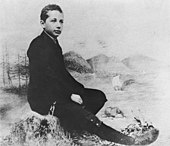Early life and education
See also: Einstein family
The Einsteins were non-observant Jews. Albert attended a Catholic elementary school from the age of five for three years. At the age of eight, he was transferred to the Luitpold Gymnasium where he received advanced primary and secondary school education until he left Germany seven years later.[11] Although it has been thought that Einstein had early speech difficulties, this is disputed by the Albert Einstein Archives, and he excelled at the first school that he attended.[12] He was right handed;[12][13] there appears to be no evidence for the widespread popular belief[14] that he was left handed.
His father once showed him a pocket compass; Einstein realized that there must be something causing the needle to move, despite the apparent "empty space".[15] As he grew, Einstein built models and mechanical devices for fun and began to show a talent for mathematics.[10] When Einstein was ten years old, Max Talmud (later changed to Max Talmey), a poor Jewish medical student from Poland, was introduced to the Einstein family by his brother, and during weekly visits over the next five years, he gave the boy popular books on science, mathematical texts and philosophical writings. These included Immanuel Kant's Critique of Pure Reason, and Euclid's Elements (which Einstein called the "holy little geometry book").[16][17][fn 1]
In 1894, his father's company failed: direct current (DC) lost the War of Currents to alternating current (AC). In search of business, the Einstein family moved to Italy, first to Milan and then, a few months later, to Pavia. When the family moved to Pavia, Einstein stayed in Munich to finish his studies at the Luitpold Gymnasium. His father intended for him to pursue electrical engineering, but Einstein clashed with authorities and resented the school's regimen and teaching method. He later wrote that the spirit of learning and creative thought were lost in strict rote learning. At the end of December 1894, he travelled to Italy to join his family in Pavia, convincing the school to let him go by using a doctor's note.[19] It was during his time in Italy that he wrote a short essay with the title "On the Investigation of the State of the Ether in a Magnetic Field."[20][21]




Tidak ada komentar:
Posting Komentar